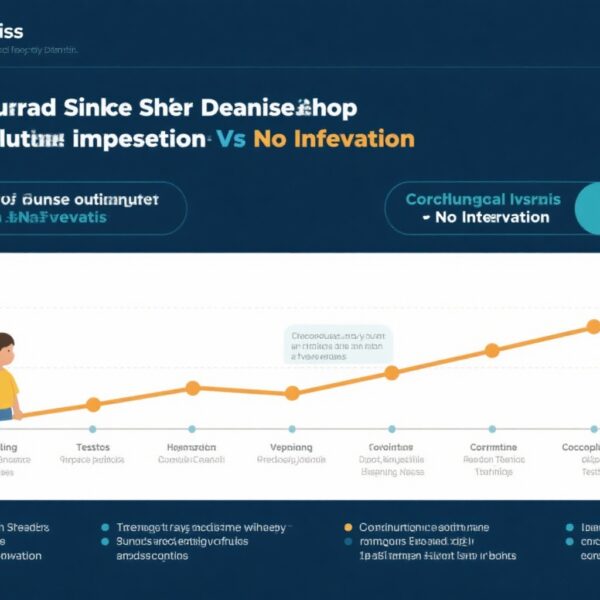Highlights
– In a 10‑year retrospective series (n=22), pediatric cochlear implantation for single‑sided deafness (SSD) produced variable long‑term outcomes; early implantation (≤1 year from onset) was associated with better speech‑in‑noise and localization benefit in most responders.
– Objective group-level improvement in BKB Sentence-in-Noise scores and localization was not demonstrated overall, likely reflecting heterogeneity in age at implantation, onset type, limited testing completion, and low average device use (~4 hours/day).
– Key practical issues include patient selection, timing of implantation, adherence to device use and rehabilitation, and the need for standardized outcome measurement in pediatric SSD research.
Background and clinical context
Single‑sided deafness (SSD) in children presents a distinct management challenge. Children with SSD have an intact acoustic ear and a deaf contralateral ear; while traditional management options include contralateral routing of sound (CROS) and bone‑conduction devices, cochlear implantation (CI) has emerged as a strategy when the goal is restoration of binaural hearing and preservation of auditory cortical development. Evidence from animal and human studies indicates that duration of unilateral auditory deprivation and age at reintroduction of binaural input influence cortical plasticity and functional outcomes. However, pediatric SSD populations are heterogeneous in age at onset (congenital vs late‑onset), etiology, and developmental risk, and the magnitude and consistency of benefit from CI remain incompletely defined.
Study design and methods
Weng et al. performed a retrospective review of Western Australian childhood hearing implant program records at Perth Children’s Hospital for the period 2014–2023, including children younger than 16 years who underwent unilateral CI for SSD. Collected data included demographics, etiology, age at diagnosis and implantation, time from onset to implantation, language assessments, Bamford‑Kowal‑Bench (BKB) Sentence-in-Noise (SIN) testing, localization testing, Speech, Spatial and Qualities of Hearing Scale (SSQ) scores, and device usage hours. Where available, within‑subject comparisons of performance with and without the CI were reported.
Key findings
Population and timing
Twenty‑two children underwent CI for SSD in the 10‑year interval. Fifty‑four point five percent were male. The average age at diagnosis was 4.2 years (range 0.0–15.1; SD 4.8). Six children (27.3%) had late‑onset SSD and 16 (72.7%) early‑onset SSD. The average time to implantation was 1.3 years (range 0.1–3.9; SD 1.3). Eleven children (50%) were classified as early CI (implanted within 1 year of onset) and 11 as late CI. The average age at implantation was 5.5 years (range 1.0–15.6; SD 4.7).
Etiology
Etiology was unknown in 8 of 22 patients (36.7%), reflecting the common diagnostic uncertainty in pediatric unilateral hearing loss.
Language outcomes
Three patients showed improvement in language ability at 1 year after implantation; no patients scored poorer compared with their pre‑implant language assessment. The report does not provide detailed standardized language score distributions for the entire cohort, limiting group‑level inferences.
Speech‑in‑noise (BKB‑SIN) outcomes
Thirteen of 22 children (59.1%) completed BKB‑SIN testing. Of those, five performed better with their CI and twelve performed worse with their CI (note: reported numbers appear to reference within‑test comparisons and may overlap given missing data). Of the five who improved, three had early‑onset SSD and two had late‑onset SSD; four of five were early CI recipients. The authors report average SNR loss as follows: early SSD group—2.91 dB (range 1.3–6) with CI versus 2.84 dB (0.5–5.5) without CI (p = 0.462); late‑onset SSD—3.72 dB (0.01–6) with CI versus 3.78 dB (0.1–7.7) without CI (p = 0.475). Averaged across all patients, the mean SNR loss with and without CI was identical (3.28 dB vs 3.28 dB), reflecting no statistically significant group‑level improvement.
Localization
Only six patients (27.3%) underwent localization testing. Reported localization accuracy was 20% with CI versus 24% without CI; the difference was not significant (p = 0.93). The small sample size and low testing completion limit interpretation.
Patient‑reported outcomes and device use
Eight patients (34.8%) completed the Speech, Spatial and Qualities of Hearing Scale (SSQ). Average CI usage, from device logs, was 4 hours per day (range 0–12.9; SD 3.7), substantially lower than typical daily use reported in successful bilateral CI or single‑sided CI cohorts. Lower device adherence may contribute to limited functional benefit.
Overall interpretation of results
Weng et al. report a heterogeneous pattern of outcomes after pediatric CI for SSD. While select patients—particularly those implanted early after onset—demonstrated measurable benefit in speech‑in‑noise and localization testing, group‑level statistical improvements were not observed for the entire cohort. The majority of objective measures were completed by a minority of participants, and average daily device use was modest.
Expert commentary and interpretation
Biological plausibility and prior literature support the concept that timely restoration of binaural input can preserve or restore neural pathways that underlie localization and binaural unmasking. Animal and human neurodevelopmental studies highlight sensitive periods during which the developing auditory system is most plastic; prolonged unilateral deprivation can lead to reorganization that limits later recovery of binaural function (see Kral & O’Donoghue 2010; Sharma et al. 2002). The Weng et al. series aligns with this model: early CI recipients (within 1 year of onset) were more likely to show benefit. However, several factors moderate the observable effect in clinical series:
- Heterogeneity in age at implantation and SSD onset (congenital vs acquired) produces variable baseline neural readiness for binaural integration.
- Small sample sizes and incomplete outcome measurement create high risk of type II error at the group level and selection bias in reported responders.
- Low average device use (mean 4 hr/day) can blunt potential benefits, since auditory learning requires consistent exposure and rehabilitative therapy.
- Standard clinical tests (BKB‑SIN, localization) may be influenced by test conditions (e.g., spatial configuration of noise and speech), coexisting language or developmental delays, and patient motivation—factors particularly relevant in pediatric cohorts.
Overall, the study reaffirmed clinically observed heterogeneity: while some children gain clear functional advantages from CI for SSD, many do not show measurable improvements on standard tests, particularly in the presence of delayed implantation, inconsistent device use, or incomplete rehabilitation.
Strengths and limitations of the study
Strengths: A real‑world, single‑centre 10‑year experience with clearly described demographics and within‑subject comparisons where available; inclusion of both objective (BKB‑SIN, localization) and patient‑reported (SSQ) outcomes; reporting of device usage.
Limitations: Retrospective design, small sample size, incomplete outcome data (many children lacked full testing), absence of standardized longitudinal language scores across the cohort, variable follow‑up intervals, and limited control for confounders such as comorbid developmental conditions. The study also lacked detailed reporting of speech and noise spatial configurations and of rehabilitative intensity, both of which affect outcomes.
Clinical implications and practical recommendations
For clinicians counseling families about CI for pediatric SSD, Weng et al. provide pragmatic takeaways:
- Early intervention matters. When feasible, implantation within a year of SSD onset appears more likely to yield measurable benefits in speech‑in‑noise and localization.
- Set realistic expectations. Not all children will show objective improvements on clinical tests; benefits may be subtle or restricted to specific listening situations, and some children will experience limited gains.
- Prioritize adherence and rehabilitation. Device usage monitoring and structured auditory and speech‑language therapy are likely important mediators of benefit and should be emphasized during preoperative counseling.
- Use standardized batteries and longitudinal follow‑up. Consistent use of age‑appropriate speech‑in‑noise and localization tests, standardized language assessments, and patient‑reported outcome measures will improve the evidence base and facilitate comparisons across centers.
- Consider alternative or adjunctive solutions. For children unlikely to benefit from CI or when families decline, non‑implant options (CROS, bone conduction devices) address audibility and some functional needs but do not restore binaural processing.
Research gaps and future directions
Key gaps highlighted by this study include the need for larger multicenter prospective cohorts with standardized pre‑ and post‑implant outcome batteries, longer and consistent follow‑up, stratification by age at onset and etiology, and incorporation of objective neurophysiologic endpoints (e.g., cortical evoked potentials, functional imaging) to track neural reorganization. Randomized trials are unlikely to be feasible for ethical and practical reasons, but well‑designed prospective observational studies and registries can clarify predictors of benefit and optimal rehabilitation strategies. Research into interventions that enhance device adherence in this population is also warranted.
Conclusions
The Western Australian 10‑year series by Weng et al. demonstrates that pediatric cochlear implantation for SSD can provide meaningful benefit for some children—particularly when implantation occurs early after onset—but outcomes are variable across a heterogeneous clinical population. Improving predictive models (who will benefit), optimizing timing, and ensuring sustained device use and rehabilitation are priorities for clinicians and researchers aiming to maximize binaural outcomes in children with SSD.
Funding and clinicaltrials.gov
Funding and clinical trial registration were not reported in the source publication.
References
1. Weng W, Gao J, Chase C, Rachel C, Jones M, Rodrigues S, Kuthubutheen J. Long-Term Outcomes of Pediatric Cochlear Implantation for Single-Sided Deafness: A Western Australian Perspective. Ear Hear. 2025 Oct 23. doi: 10.1097/AUD.0000000000001725. Epub ahead of print. PMID: 41128554.
2. Kral A, O’Donoghue GM. Profound deafness in childhood. Lancet Neurol. 2010 Mar;9(3):241–52.
3. Sharma A, Dorman MF, Spahr AJ. A sensitive period for the development of the central auditory system in children with cochlear implants: implications for age of intervention. Ear Hear. 2002 Oct;23(6):532–9.
AI image prompt for article thumbnail
Photorealistic scene of a young child (preschool age) in a modern audiology clinic wearing a behind‑the‑ear cochlear implant processor on the right ear, sitting on a colorful chair while a speech therapist points to a picture book; warm daylight through a window, soft focus background with audiology equipment visible, optimistic and clinical tone.



